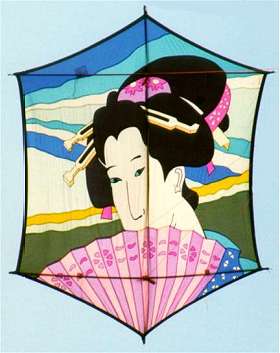


Children in Japan often celebrate New Year's Day by flying long-tailed kites. The kites may be in any shape and may be very large or very small. They are usually made of paper or cloth over a wooden frame, but they also can be made of plastic. A favorite decoration is a dragon with a fierce face and a long tail. Some kites have faces of demons or brave soldiers painted on them.
Many Japanese children design and build their own kites. They make them look like butterflies, cranes or even fish. Some kites have wings or tails on them. Box kites are made for flying on very windy days.
HATA KITE
A Japanese fighter kite beautifully made and decorated by Seiko Nakamura one of
best Hata kite makers in Japan.
The most important part of building kites is being able to fly them, either alone or with other people. Japanese children like to challenge others to launch and guide kites into the sky. Sometimes they have kite fights. In one area of Japan, knife-blades are fastened to kite strings so that those flying them can try to cut a competitor's string and make that kite fly off into the sky.
HIRADO
ONIYOCHO
A kite from Hirato -Nagasaki area
The large staring eyes and sharp teeth represent the helmet worn by the Samurai
Warrior who needed to be easily recognizable on the battlefield by their own
soldiers and commanders.
If it has a face beneath the helmet only the children of the Samurai should fly
it. The bamboo frame is one of the most complex of Japanese kites.
| DARUMA DAKO Daruma means Boditharma who was an Indian Zen Monk, who introduced Buddhism into China. It is said he prayed and meditated for nine years without moving and lost the use of his legs. He is always painted without legs and is a symbol of patience. He is also famous for his staring and fierce eyes. Daruma is depicted on many Japanese kites. Made and painted by Mikio Toki one of Japan's best kite makers. |
| HATA KITE A Japanese fighter kite beautifully made and decorated by Seiko Nakamura one of best Hata kite makers in Japan. |
|
|
|
LARGE EDO
KITE A 3 metre high Edo kite. Applique by David Bailey. |
 |
ROKKAKO
FIGHTER KITE ROKU means six -- Kaku means corners. Another Japanese fighting kite and flown at the Shirone Kite Festival each May. Teams of kite fliers gather on both river bank and try to entangle their flying lines then proceed to cut each others kites lines or pull the kites to their side of the river. Normally decorated with famous warriors, folk heroes or advertisement. This beautifully appliqued kite made by David Baille is 2 metres heigh and taken part in many Rokkako fights in both England and abroad. |
|
NAGOYA KORYU SEMI KITES There are three types of Nagoya Koryu kites - Abu
means horsefly, Semi means cicada, and Hatchi means bee. |